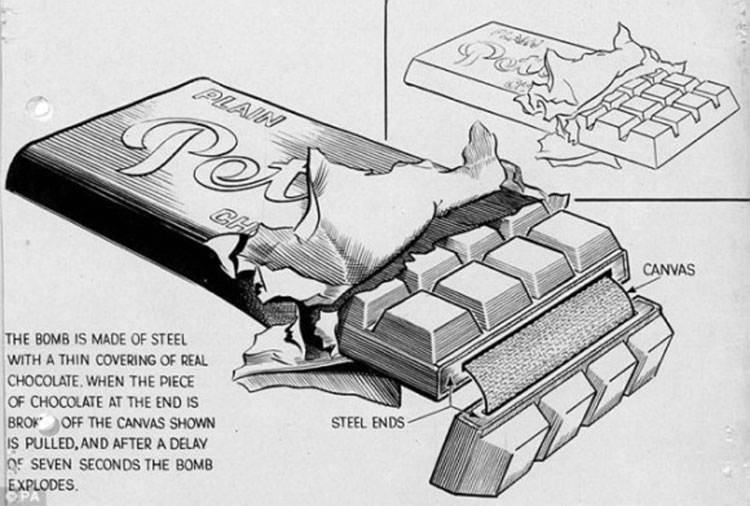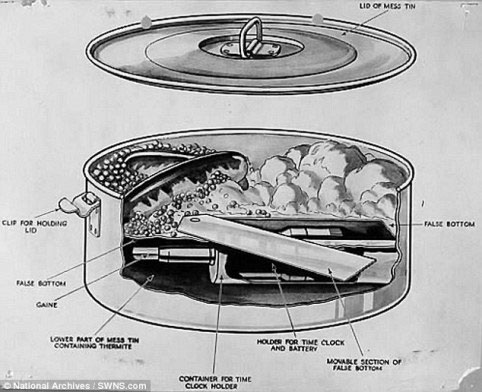Nazi Nazi regime chocolate bombs assassinate British Prime Minister
This deadly candy bar has a black cover, printed with the words 'Peter's Chocolate', pretending to be a chocolate brand used inside the War room where the British leaders sat and discussed.
The drawings announced by MI5 Intelligence Agency recently brought to the restaurant terminology about 'death by chocolate' a new meaning. These drawings describe hidden bombs developed by Nazi Germany during World War II, including an explosive candy bar for former British Prime Minister Winston Churchill.

Sketches of chocolate bombs made by German fascists.
While the Nazis bombed the UK, Adolf Hitler's forces were also trying to design clever bombing traps and the friendliest appearance possible. As the war continued, MI5 discovered Nazi secret sabotage to hide explosives in everyday objects like a plum box, oil can, shaving brush and lumps of coal. . This intelligence agency even grasped the plot of fascists to develop potato sausages and porridge into an explosive.
In the spring of 1943, MI5 official Victor Rothschild discovered a cleverly disguised bomb - a chocolate bar exploded . This deadly candy bar has a black cover, printed with the words 'Peter's Chocolate ', pretending to be a chocolate brand used inside the War room where the British leaders sat and discussed. Inside that pure black chocolate layer is actually a steel core and cloth, when someone breaks a piece of candy, the fabric will be pulled out, activating the inner bomb to explode after about 7 seconds. That amount of explosives is enough to kill anyone within a few meters around. MI5 believed that secret agents of the Nazis had attempted to blend this explosive chocolate into the meeting room to assassinate the then-Prime Minister Churchill, a man who enjoyed eating sweet candy.

Bombs camouflage the bottom of the pot.
Victor Rothschild, who was an experienced biologist in peacetime and held a key position in his family's well-known banking system, was recruited to be MI5's commander of vandalism and explosives. In order to warn the public widely, Rothschild asked the son of a colleague, young man Laurence Fish, to sketch out the Nazi camouflage bomb traps.
In a letter to Fish on May 4, 1943, Rothschild wrote from a secret cellar deep in the heart of London: '"We received information that the enemy was using a bar made of steel, I have a chocolate coating that is very thin on the outside, I want to ask you to draw me a chocolate bar to explode . peeled half of wrapping paper, exposing a piece of candy bar and another with a piece of candy broken, showing the fiber fabric pulled out from within. ' Through Rothschild's description, inside a candy bar containing strong explosives and a slow detonation mechanism.
The letter marked 'secret' , was found by Fish's wife in 2009, after his death. However, his original drawings have lost track for decades. Until last summer, the family of Rothschild's intelligence chief found some of Fish's drawings as they cleaned up the file cabinets at their home in Suffolk, England. Rothschild's daughter gave them to Fish's wife.
- Interesting facts about the British Prime Minister's palace
- 56 jars in the tomb of the prime minister of Egypt contain great secrets
- Scientists spread bacteria onto Nazi bombs submerged under the sea
- 'Hack' 'computer in Prime Minister Blair's office
- Electricity of the Prime Minister: Prohibiting poultry in inner city and inner city
- The Prime Minister directs: Mobilizing many forces to participate in epidemic prevention and control
- The misplaced scientific manuscript of the former British prime minister about extraterrestrial life
- Picture of the life and career of former Singapore Prime Minister Lee Kuan Yew
- Important milestones in the life of Lee Kuan Yew
- Fat in chocolate can be replaced with fruit juice
- How does Ly Quang Dieu teach children?
- Eating chocolate makes you smarter
 'Fine laughs' - Scary and painful torture in ancient times
'Fine laughs' - Scary and painful torture in ancient times The sequence of numbers 142857 of the Egyptian pyramids is known as the strangest number in the world - Why?
The sequence of numbers 142857 of the Egyptian pyramids is known as the strangest number in the world - Why? History of the iron
History of the iron What is alum?
What is alum?